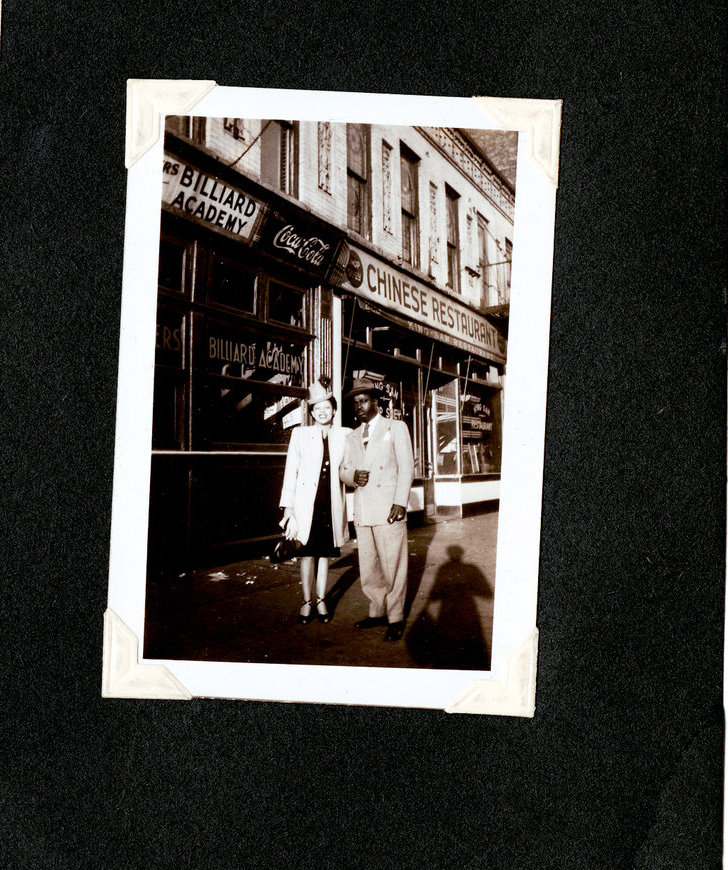One night six years ago, on a quiet side street in Crown Heights, Brooklyn, I came across a photo album that had been put out with the trash. I lived around the corner, and I was walking home when I saw it sitting beneath a streetlamp on Lincoln Place.
It looked handmade, with a wooden cover bound with a shoelace. But it had been tied up with twine, like a bunch of old newspapers, and left atop a pile of recycling.
After hesitating a moment, I picked it up and took it home.
The pages were fragile, and they cracked when I turned them, as if the album hadn’t been opened in a long time, but the photos were perfectly preserved. They seemed to chronicle the life of a black couple at midcentury: a beautiful woman with a big smile and a man who looked serious, or was maybe just camera-shy, and had served in World War II.
[mc4wp_form id=”6042″]
As I turned the pages, the scenery changed from country picnics to city streets and crowded dance halls in what appeared to be Harlem, and the couple went from youth to middle age. Looking at the album, I was struck by how joyful the photos were — and by the fact that as fabled as this era was, I had never seen a black family’s own account of that time.
I wondered who these neighbors were, and who had thrown the album out.
For decades, this part of Crown Heights had been mostly black. When I arrived in the neighborhood, several years before, I was one of the few nonblack residents on the block. The neighborhood was changing, though; newcomers were arriving and longtime residents were moving out.
 Photo | Credit: Annie Correal, The New York Times
Photo | Credit: Annie Correal, The New York Times
 Photo | Credit: Annie Correal, The New York Times
Photo | Credit: Annie Correal, The New York Times
 Photo | Credit: Annie Correal, The New York Times
Photo | Credit: Annie Correal, The New York Times
 Credit: Annie Correal, The New York Times[/caption]Photo | Credit: Annie Correal, The New York Times
Credit: Annie Correal, The New York Times[/caption]Photo | Credit: Annie Correal, The New York Times
 Photo | Credit: Annie Correal, The New York Times
Photo | Credit: Annie Correal, The New York Times
 Photo | Credit: Annie Correal, The New York Times
Photo | Credit: Annie Correal, The New York Times
Brooklyn (/ˈbrʊklᵻn/) is the most populous of New York City’s five boroughs, with a Census-estimated 2,636,735 residents in 2015. It borders the borough of Queens at the southwestern end of Long Island. Since 1896, Brooklyn has had the same boundaries as Kings County, the most populous county in the U.S. state of New York, and the second-most densely populated county in the United States, after the county of New York (which is coextensive with the borough of Manhattan).
With a land area of 71 square miles (180 km2) and water area of 26 square miles (67 km2), Kings County is New York’s fourth-smallest county by land area and third-smallest by total area, though it is the second-largest among the city’s five boroughs. Today, if it were a separate city, Brooklyn would rank as the fourth-most populous city in the U.S., behind the combined other boroughs of New York City, Los Angeles and Chicago.
Brooklyn was an independent incorporated city (and previously an authorized village and town within the provisions of the New York State Constitution) until January 1, 1898, when, after a long political campaign and public relations battle during the 1890s, according to the new Municipal Charter of “Greater New York”, Brooklyn was consolidated with the other cities, boroughs, and counties to form the modern “City of New York,” surrounding the Upper New York Bay with five constituent boroughs. The borough continues, however, to maintain a distinct culture. Many Brooklyn neighborhoods are ethnic enclaves. Brooklyn’s official motto, displayed on the Borough seal and flag, is Eendraght Maeckt Maght which translates from early modern Dutch as “Unity makes strength”.
In the first decades of the 21st century, Brooklyn has experienced a renaissance as an avant garde destination for hipsters, with concomitant gentrification, dramatic house price increases, and a decrease in housing affordability. Since 2010, Brooklyn has evolved into a thriving hub of entrepreneurship and high technology startup firms, and of postmodern art and design. (Wikipedia).


You must be logged in to post a comment.